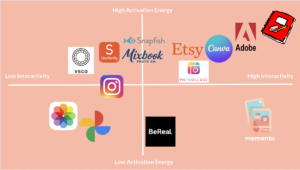
Comparative Research
After conducting deeper research, we decided to choose interactivity and activation energy as our main axes for our comparator diagram. We thought these axes would broadly encapsulate many of the nuanced distinctions between our product and potential competitors across different fields.
Interactivity generally indicates how engaged a user is with the product itself, during and after the process of interfacing with it. For example, interactivity in the context of memento would be the process of submitting daily photos and prompts, as well as the tangibility of the product after it is actually mailed to the user – this is something we would consider high interactivity. On the contrary, the photo app is something that would be considered less interactive because the process of using the app is probably generally passive scrolling and casual browsing every once in a while.
Activation energy generally encompasses how much effort and time a user puts into interfacing with the product. For example, activation energy in the context of memento would be a few minutes per day just to take a picture or answer a prompt, which is relatively low-stakes and easy. On the contrary, physical journaling is something with higher activation energy, because it requires a significant amount of time and energy invested for the user to sit down and think of something to write and write it out and add any potential references or features.
The companies and products we chose to include are representative of several different general “groups” of use cases – for example, BeReal and Instagram and VSCO are all social media platforms that people use for different purposes; Etsy and Snapfish and Mixbook are all platforms where users can take time to upload their own photos to be shipped to them; Photos apps are just generic locales where photos are stored and occasionally looked back upon; Canva, Adobe, and PicCollage are all platforms where users can individually reference and design an isolated snapshot of certain memories to share with others (usually digitally).
We envision memento being positioned in a state of high interactivity and low activation energy, which is the ideal we hope to achieve and sets it apart from competitors. It is easy and low-stakes to use, requiring minimal user effort to assemble, while still maintaining interaction and engagement. After the physical photo journal itself is delivered, it is a uniquely physical product that can be shared with others and reflected upon individually – the tangibility allows it to be highly interactive.
Participatory Roadmap
Link to slides below — insights in speaker notes
https://docs.google.com/presentation/d/1tYwHaz-ZVyqygAc6J8iBrMs1i-LV0OauW_KWLHh5Ay0/edit?usp=sharing

